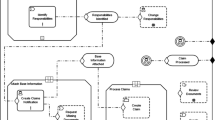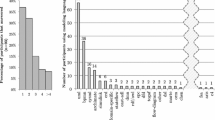Abstract
BPMN 2.0 is an OMG standard and one of the leading process modelling notations. Although the current language specification recognises the importance of defining a visual notation carefully, it does so by relying on common sense, intuition and emulation of common practices, rather than by adopting a rigorous scientific approach. This results in a number of suboptimal language design decisions that may impede effective model-mediated communication between stakeholders. We demonstrate and illustrate this by looking at BPMN 2.0 through the lens of the Physics of Notations, a collection of evidence-based principles that together form a theory of notation design. This work can be considered a first step towards making BPMN 2.0’s visual notation more cognitively effective.
Access this chapter
Tax calculation will be finalised at checkout
Purchases are for personal use only
Preview
Unable to display preview. Download preview PDF.
Similar content being viewed by others
References
OMG: Business Process Model and Notation (BPMN) Specification 2.0 V0.9.15. Object Management Group Inc. (2009)
Moody, D.L.: The “Physics” of Notations: Towards a Scientific Basis for Constructing Visual Notations in Software Engineering. IEEE Transactions on Software Engineering 35, 756–779 (2009)
Larkin, J., Simon, H.: Why a Diagram Is (Sometimes) Worth Ten Thousand Words. Cognitive Science 11, 65–99 (1987)
Britton, C., Jones, S.: The Untrained Eye: How Languages for Software Specification Support Understanding by Untrained Users. Human Computer Interaction 14, 191–244 (1999)
Kosslyn, S.M.: Graphics and Human Information Processing: A Review of Five Books. Journal of the American Statistical Association 80(391), 499–512 (1985)
Hitchman, S.: The Details of Conceptual Modelling Notations are Important - A Comparison of Relationship Normative Language. Communications of the AIS 9(10) (2002)
Recker, J., Rosemann, M., Indulska, M., Green, P.: Business Process Modeling - a Comparative Analysis. Journal of the Association for Information Systems (JAIS) 10(4), 333–363 (2009)
van der Aalst, W., ter Hofstede, A.: YAWL: Yet Another Workflow Language. Information Systems Journal 30(4), 245–275 (2005)
Green, T., Blandford, A., Church, L., Roast, C., Clarke, S.: Cognitive Dimensions: Achievements, New Directions, and Open Questions. Journal of Visual Languages and Computing 17, 328–365 (2006)
Moody, D.L.: Theory Development in Visual Language Research: Beyond the Cognitive Dimensions of Notations. In: Proc. of the IEEE Symposium on Visual Languages and Human-Centric Computing (VLHCC 2009), pp. 151–154 (2009)
Krogstie, J., Sindre, G., Jorgensen, H.: Process Models Representing Knowledge for Action: a Revised Quality Framework. European Journal of Information Systems 15, 91–102 (2006)
Krogstie, J., Solvberg, A.: Information systems engineering - conceptual modeling in a quality perspective. In: Kompendiumforlaget, Trondheim, Norway (2003)
Popper, K.R.: Science as Falsification. In: Routledge, Keagan, P. (eds.) Conjectures and Refutations, London, pp. 30–39 (1963)
Moody, D.L.: Review of archimate: The road to international standardisation. Technical report, Report commissioned by the ArchiMate Foundation and BiZZDesign B.V, Enschede, The Netherlands (2007)
Moody, D., van Hillegersberg, J.: Evaluating the visual syntax of UML: An analysis of the cognitive effectiveness of the UML family of diagrams. In: Gašević, D., Lämmel, R., Van Wyk, E. (eds.) SLE 2008. LNCS, vol. 5452, pp. 16–34. Springer, Heidelberg (2009)
Moody, D.L., Heymans, P., Matulevičius, R.: Improving the Effectiveness of Visual Representations in Requirements Engineering: An Evaluation of i* Visual Syntax (Best Paper Award). In: Proc. of the 17th IEEE International Requirements Engineering Conference (RE 2009), Washington, DC, USA, pp. 171–180. IEEE Computer Society, Los Alamitos (2009)
Genon, N., Amyot, D., Heymans, P.: Analysing the Cognitive Effectiveness of the UCM Visual Notation (to appear, 2010)
Bertin, J.: Sémiologie graphique: Les diagrammes - Les réseaux - Les cartes. Gauthier-VillarsMouton & Cie (1983)
Mendling, J., Reijers, H., van der Aalst, W.: Seven Process Modelling Guidelines (7PMG). Information and Software Technology 52(2), 127–136 (2010)
Mendling, J., Reijers, H., Cardoso, J.: What Makes Process Models Understandable? In: Alonso, G., Dadam, P., Rosemann, M. (eds.) BPM 2007. LNCS, vol. 4714, pp. 48–63. Springer, Heidelberg (2007)
Schrepfer, M., Wolf, J., Mendling, J., Reijers, H.: The Impact of Secondary Notation on Process Model Understanding. In: Persson, A., Stirna, J. (eds.) PoEM 2009. Lecture Notes in Business Information Processing, vol. 39, pp. 161–175. Springer, Heidelberg (2009)
Figl, K., Mendling, J., Strembeck, M., Recker, J.: On the Cognitive Effectiveness of Routing Symbols in Process Modeling Languages. In: Abramowicz, W., Tolksdorf, R. (eds.) BIS 2010. Lecture Notes in Business Information Processing, vol. 47, pp. 230–241. Springer, Heidelberg (2010)
Mendling, J., Recker, J., Reijers, H.A.: On the Usage of Labels and Icons in Business Process Modeling. Computer, 40–58 (2010)
Figl, K., Mendling, J., Strembeck, M.: Towards a Usability Assessment of Process Modeling Languages. In: Proc. of the 8th Workshop Geschäftsprozessmanagement mit Ereignisgesteuerten Prozessketten (EPK 2009), Berlin, Germany. CEUR Workshop Proceedings, vol. 554, pp. 118–136 (2009)
Reijers, H.A., Mendling, J.: Modularity in Process Models: Review and Effects. In: Dumas, M., Reichert, M., Shan, M.-C. (eds.) BPM 2008. LNCS, vol. 5240, pp. 20–35. Springer, Heidelberg (2008)
Muehlen, M.z., Recker, J.: How Much Language Is Enough? Theoretical and Practical Use of the Business Process Modeling Notation. In: Bellahsène, Z., Léonard, M. (eds.) CAiSE 2008. LNCS, vol. 5074, pp. 465–479. Springer, Heidelberg (2008)
Genon, N., Heymans, P., Moody, D.L.: BPMN 2.0 Process Models: Analysis according to the “Physics” of Notations Principles. Technical report, PReCISE - University of Namur (2010), http://www.info.fundp.ac.be/~nge/BPMN/BPMN2_PoN_Analysis.pdf
Vessey, I.: Cognitive Fit: A Theory-based Analysis of the Graphs versus Tables Literature. Decision Sciences 22, 219–240 (1991)
Koedinger, K., Anderson, J.: Abstract planning and conceptual chunks: Elements of expertise in geometry. Cognitive Science 14, 511–550 (1990)
Winn, W.: An Account of How Readers Search for Information in Diagrams. Contemporary Educational Psychology 18, 162–185 (1993)
Blankenship, J., Danseraeau, D.F.: The effect of animated node-link displays on information recall. The Journal of Experimental Education 68(4), 293–308 (2000)
Persson, A.: Enterprise Modelling in Practice: Situational Factors and their Influence on Adopting a Participative Approach. PhD thesis, Department of Computer and Systems Sciences, Stockholm University (2001)
Goodman, N.: Languages of Art: An Approach to a Theory of Symbols. Bobbs-Merrill Co., Indianapolis (1968)
Winn, W.: Encoding and Retrieval of Information in Maps and Diagrams. IEEE Transactions on Professional Communication 33(3), 103–107 (1990)
Biederman, I.: Recognition-by-Components: A Theory of Human Image Understanding. Psychological Review 94(2), 115–147 (1987)
Green, D.M., Swets, J.A.: Signal Detection Theory and Psychophysics. Wiley, Chichester (1966)
Petre, M.: Why Looking Isn’t Always Seeing: Readership Skills and Graphical Programming. Communications of ACM 38(6), 33–44 (1995)
Masri, K., Parker, D., Gemino, A.: Using Iconic Graphics in Entity Relationship Diagrams: The Impact on Understanding. Journal of Database Management 19(3), 22–41 (2008)
Pierce, C.: The Essential Writings. Prometheus Books (1998)
Bar, M., Neta, M.: Humans Prefer Curved Visual Object. Psychological Science 17(8), 645–648 (2006)
Citrin, W.: Strategic Directions in Visual Languages Research. ACM Computing Surveys 24(4) (1996)
Flood, R., Carson, E.: Dealing with Complexity: an Introduction to the Theory and Application of Systems Science. Plenum Press, New York (1993)
Silver, B.: BPMN Method and Style. Cody-Cassidy Press (June 2009)
Lynch, K.: The Image of the City. MIT Press, Cambridge (1960)
Lamping, J., Rao, R.: The Hyperbolic Browser: a Focus + Context Technique for Visualizing Large Hierarchies. Journal of Visual Languages and Computing 7, 33–55 (1999)
Turetken, O., Schuff, D., Sharda, R., Ow, T.: Supporting Systems Analysis and Design Through Fisheye Views. Communications of ACM 47(9), 72–77 (2004)
Kim, J., Hahn, J., Hahn, H.: How Do We Understand a Systeme with (So) Many Diagrams? Cognitive Integration Processes in Diagrammatic Reasoning. Information Systems Research 11(3), 284–303 (2000)
Paivio, A.: Mental Representations: A Dual Coding Approach. Oxford University Press, Oxford (1986)
Mendling, J., Recker, J., Reijers, H.: On the Usage of Labels and Icons in Business Process Modeling. International Journal of Information System Modeling and Design, IJISMD (2009)
Nordbotten, J., Crosby, M.: The Effect of Graphic Style on Data Model Interpretation. Information Systems Journal 9(2), 139–156 (1999)
Miller, G.A.: The Magical Number Seven, Plus or Minus Two: Some Limits on Our Capacity for Processing Information. Psycological Review, 81–97 (1956)
Davies, I., Green, P., Rosemann, M., Indulska, M., Gallo, S.: How Do Practitioners Use Conceptual Modelling in Practice? Data and Knowledge Engineering 58, 358–380 (2006)
Author information
Authors and Affiliations
Editor information
Editors and Affiliations
Rights and permissions
Copyright information
© 2011 Springer-Verlag Berlin Heidelberg
About this paper
Cite this paper
Genon, N., Heymans, P., Amyot, D. (2011). Analysing the Cognitive Effectiveness of the BPMN 2.0 Visual Notation. In: Malloy, B., Staab, S., van den Brand, M. (eds) Software Language Engineering. SLE 2010. Lecture Notes in Computer Science, vol 6563. Springer, Berlin, Heidelberg. https://doi.org/10.1007/978-3-642-19440-5_25
Download citation
DOI: https://doi.org/10.1007/978-3-642-19440-5_25
Publisher Name: Springer, Berlin, Heidelberg
Print ISBN: 978-3-642-19439-9
Online ISBN: 978-3-642-19440-5
eBook Packages: Computer ScienceComputer Science (R0)




